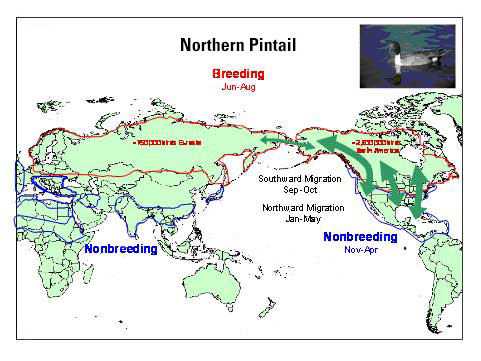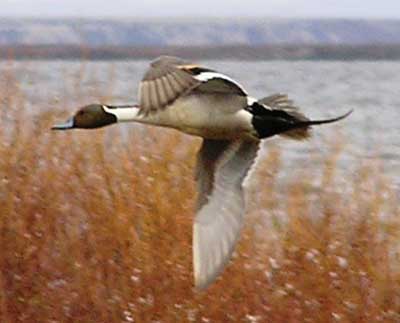Northern Pintail, Anas acuta
High-Priority Species ListSpring pintails may be sampled extensively from a subsistence harvest of 15-20,000 birds, or through capture of live birds and directed collecting. Fall pintails can be captured on molting and staging areas across Alaska, and samples can be taken from hunter-harvested birds. These populations likely include some North American wintering birds that crossed the Bering Strait for a portion of the summer, as well as Asian wintering birds that have not departed for wintering areas yet.
Spring
We recommend a geographically stratified sampling design for spring arrival/pre-nesting birds. Sampling strata (and associated strata priority) are broadly defined as Yukon-Kuskokwim Delta (high), Seward Peninsula - including Kotzebue Sound - (high), St. Lawrence Island (high), Bristol Bay (low), and the Arctic Coastal Plain (low). High priority designations among these strata are based on subjective opinions regarding relative abundance of pintails and the likelihood of encountering Asian wintering birds. Spring arrival birds are difficult to capture efficiently, thus we recommend that sampling be based on collected birds: either subsistence harvested birds, or birds specifically collected for this study. Pintails are a widespread and common duck in traditional spring subsistence harvests. Roughly 15-20,000 pintails are taken annually for subsistence, mostly during spring. On the Y-K Delta alone, 8-10,000 pintails are taken during spring. With an appropriate program to gain access to harvested birds, a representative sample of pintails could be obtained in key strata. Influenza sampling will be by cloacal swab from collected birds. Ideal sample size is 200 per strata with collections spread across each stratum. However, we acknowledge that logistic constraints will make sample size and distribution within strata problematic.
Fall
We propose a geographic stratification targeting known concentrations of molting or staging pintails, as well as principal fall harvest areas. Sampling strata (and associated strata priority) include Yukon-Kuskokwim Delta (high), Innoko NWR (medium), St. Lawrence Island (high), Lower Yukon Valley (Koyukuk/Nowitna) (medium), Minto Flats (high), Yukon Flats (medium), Cook Inlet (medium), Seward Peninsula and Kotzebue Sound (high), Izembek Lagoon (high) and Arctic Coastal Plain (medium). Within each stratum we propose a cluster sample design targeting 200 birds spread across 3-4 sampling (i.e. trap) locations (i.e., clusters): 50 from each location. Sampling would occur in late July and August and will sample mostly adult males with fewer females and hatch year birds. Pintails will be captured during summer with baited live traps or rocket nets. Sampling will be by cloacal swab from live-captured birds. Using this capture approach there will be substantial opportunity to sample other dabbling ducks such as Mallards and Green-winged Teal. In addition, samples will be obtained from hunter-shot pintails where sufficient access to hunters and birds can be arranged. Pintails rank second (18%) in the fall dabbling duck bag, totaling about 11-12,000. Samples of pintails originating in northern and interior Alaska can be obtained at Minto Flats and in the Tanana Valley. Pintails migrating from southern and western Alaska can be sampled in Cook Inlet (42% of fall sport-harvested ducks).
Sampling timeframe: May through mid September.
Sample demographics: Spring sampling will be from after-hatch-year males and females. Fall sampling will be adults as well as hatch year birds of both sexes.
Methods of capture: Spring sampling will focus on subsistence harvested birds. Fall sampling will be from a combination of live birds captured over bait and hunter harvested birds. Sport harvested birds will be sampled where there is adequate access to hunters.
Other targeted species: Numerous other species will be encountered during spring subsistence sampling. Other species likely to be encountered include Black Brant, Emperor Geese, Long-tailed Ducks, Tundra Swans and Lesser Sandhill Cranes. Numerous other unranked species will also be encountered.
Harvest sampling: Samples can likely be obtained from sport harvested birds in several areas where substantial harvest occurs. However, some of these same areas will also be sampled just prior to hunting season with live captures. Samples from sport harvested birds will be used to increase the total species sample and to provide sampling during fall migration when birds aggregate on staging areas and sex-age composition varies.
Contact: Julian Fischer
Yukon Delta NWR (Spring arrival and July/August Captures)
Innoko NWR (July/August captures)
Koyukuk-Nowitna NWR (July/August captures)
Yukon Flats NWR (July/August captures)
Izembek NWR (fall sampling)
Togiak NWR (Spring arrival sampling)
Selawik NWR (spring and fall sampling)
Alaska Department of Fish and Game
Cook Inlet (July/August captures, sport harvest sampling in all areas)
Contact: Mike Petrula
North Slope Borough (late summer/fall Arctic Coastal Plain sampling)
Smith, R. I. 1970. Response of pintail breeding population to drought. Journal of Wildlife Management 34:943-946.
Nicholi, C., P. L. Flint, and M. Wege. 2005. Annual survival, recovery rates, and site fidelity of Northern Pintails banded on the Yukon-Kuskokwim Delta, Alaska. Journal of Wildlife Management 69:1202-1210.
Miller, M. R., J. Y. Takeawa, J. P. Fleskes, D. L. Orthmeyer, M. L. Casazza, and W. M. Perry. 2005. Spring migration of Northern Pintials from California’s central valley wintering area tracked with satellite telemetry: routes, timing and destinations. Canadian Journal of Zoology 83:1314-1332.

Ranking Score: 15.0
Asian H5N1 ranking criteria for Northern Pintail, Anas acuta.
Total of partial contact with Asia1 |
Contact with known "hot spot"2 |
Habitat used in Asia3 |
Pop. in Alaska4 |
Can samples be obtained? |
Score |
2.0 |
2.0 |
4.0 |
4.0 |
3.0 |
15.0 |
Unknown number of Siberian-breeding birds migrate through Alaska to winter in North America |
Asian summer range overlaps with known AI-infected areas |
Freshwater marshes, ephemeral wetlands |
Summer population approximately 1 million |
Easy to capture in Alaska in autumn |

